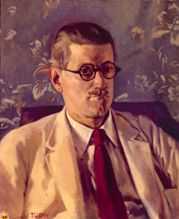A Painful Case
| "A Painful Case" | |
|---|---|
| Author | James Joyce |
| Country |
|
| Language | English |
| Genre(s) | short story |
| Published in | Dubliners |
| Publication type | Collection |
| Media type | |
| Publication date | 1914 |
| Preceded by | ""Clay"" |
| Followed by | ""Ivy Day in the Committee Room"" |
"A Painful Case" is a short story by Irish author James Joyce, published in his 1914 collection Dubliners.[1]
The story
Mr. Duffy, a middle-aged bank cashier, deliberately lives in an isolated suburb of Dublin. He is characterized as very meticulous and ordered and has little social contact. At a concert one night, Duffy makes the acquaintance of Mrs. Emily Sinico, a married mother. They start up a relationship that is innocent enough to be condoned by Mrs. Sinico’s husband, who believes the two's discussions revolve mostly around his daughter and the possibility of a relationship between her and Duffy. The two draw closer together, and one night Mrs. Sinico impulsively takes his hand and presses it to her cheek, but Duffy is not pleased at the development and ends their meetings. Four years later, he reads that Mrs. Sinico has been struck by a train and killed. The newspaper article, the title of which provides the title of the story, contains an account by her husband, who states that she began drinking two years ago. The details of the accident suggest that she may have committed suicide. He reacts at first with revulsion, concluding that some inherent weakness led to her drinking and the accident, but he slowly comes to believe that it was his rejection that condemned her to solitude and death. He reflects on his own loneliness: "No one wanted him; he was outcast from life's feast." The story ends with Duffy listening to the silence of the surrounding night atop a hill overlooking Dublin where he and Sinico used to sit down and talk, where he realizes just how lonely he really is.
Details
• Bile Beans —a popular patent medicine in Ireland during Joyce’s day.
• the Rotunda —a group of buildings next to the maternity hospital on Rutland Square (now Parnell Square), one of which is a concert hall.
• astrakhan —a wool fabric with a pile cut and curled to look like a loosely curled fur made from the pelt of very young lambs originally bred near Astrakhan, a city and port in southwest Russia.
• Earlsfort Terrace —the location of the Dublin International Exhibition Building, a concert venue at the time this story takes place.
• Leghorn —a seaport in Tuscany, western Italy, on the Ligurian Sea (The Italian name is Livorno.)
• Parkgate —the main entrance to Phoenix Park, the large public park in northwest Dublin.
• the buff Mail —the Dublin Evening Mail, which was printed on buff (brownish-yellow) paper.
• reefer —an overcoat; a short, thick, double-breasted coat in the style of a seaman’s jacket.
• the prayers —Secret prayers in the Roman Catholic mass between the Offertory and the Preface, read silently or quietly by the priest.
• Sydney Parade —a train station on Sydney Parade Avenue, in the village of Merrion, southeast of Dublin.
• Leoville —apparently the name of the house in which the Sinicos lived.
• a league —a temperance association; its members would have pledged to avoid alcohol.
• the Herald —the Dublin Evening Herald.
References
- Joyce, James. Dubliners (London: Grant Richards, 1914)
External links
| ||||||||||||||||||||||||||||||||||||||||||||||||||||||||
